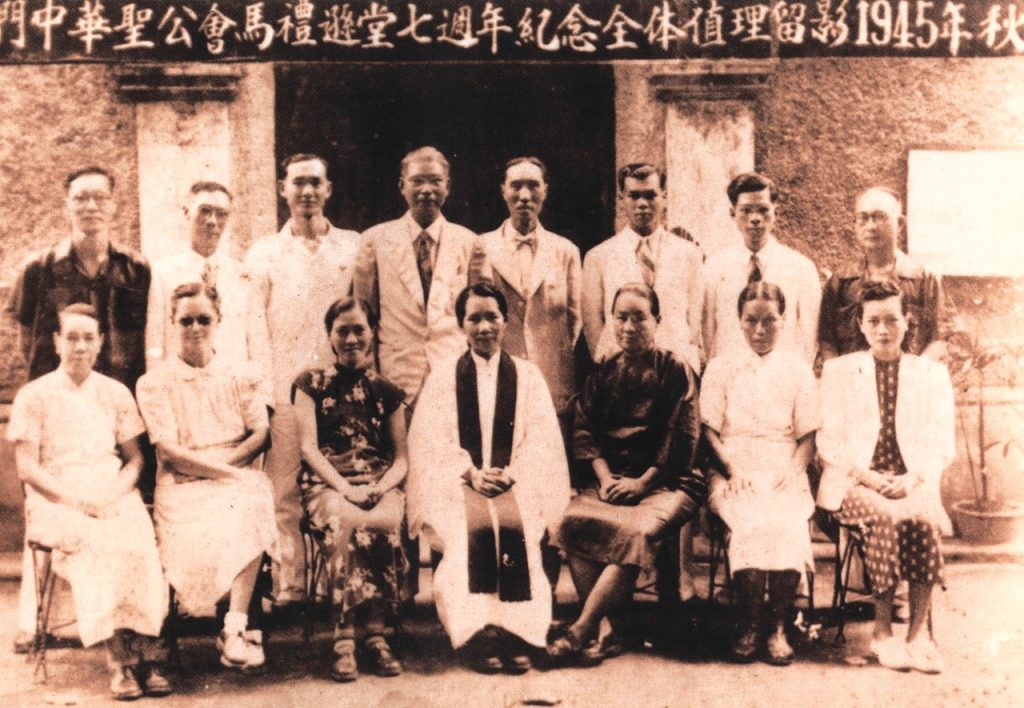Dear colleagues,
During World War II, the Diocese of Hong Kong found itself in a tight spot. Refugees were leaving mainland China and coming to places like Hong Kong and Macao (which was also in the diocese). Travel was difficult and dangerous, and resources and food were scarce. When Hong Kong itself fell to the Japanese, even more people were displaced. Anglican church leaders tried to respond to the great human need they encountered but there were an insufficient number of clergy and it was difficult to access all parishes in the diocese.
In the middle of this situation was a woman named Li Tim Oi (who was sometimes known by the English name Florence). In 1941, at the age of 34, she had been ordained a deacon at St. John’s Cathedral in Hong Kong. Afterwards, she was sent to Macao. Given the dangers of the war, to get back and forth between Hong Kong and Macao she often had to disguise herself as an older woman or travel in small boats that could more easily evade the Japanese military.
In Macao, Li Tim Oi’s ministry focused on the great needs of the people there. As she recalled, “There was hardly any food, it was so scarce. Many people starved to death. Even if you had money it was difficult to buy rice. The merchants controlled the market and kept the rice scarce and the price high.” It was not uncommon on her walk to church in the morning to pass the bodies of those who had died of hunger the night before. Through her resourcefulness, she managed to find a source of rice and help distribute it to members of her congregation and others in need. She helped arrange medical care for those who needed it and taught children in an informal school. She visited the mortuary to help people identify deceased family members and performed countless funerals. Her ministry was all-encompassing and through her ministry not only were people’s needs served but more people began to join the church.
The pace of her ministry was also unrelenting. As she later said: “I was working long hours, and I got to bed very late. Sometimes there would be midnight emergencies, when people would knock on the door and get me up. I would start work again at six o’clock. One day the doctor tested my chest. ‘If you carry on working like this,’ he said, ‘you will die very soon.’ But how could I stop? I didn’t sleep enough. I felt my heart pounding all the time, yet with so much to do I felt sure God would not let me die. I didn’t fear death, even though death was all around me.” I recently received a copy of a photographic history of Anglicanism in China and there is a striking picture of Li Tim Oi with the vestry of her church in 1945. I am struck by how young everyone in the picture is, including Li Tim Oi, and how determined they seem.
 As the war dragged on, it was harder and harder for priests to come to Macao even occasionally to offer sacramental ministry. At her ordination as a deacon, Li Tim Oi had been given permission to baptize, marry, and perform funerals. But she couldn’t preside at Communion. Finally, in 1943, the Bishop of Hong, Ronald Hall, decided that Li Tim Oi was effectively performing the ministry of a priest and should be ordained one. And that’s what he did: on January 25, 1944, after a difficult journey to the bishop in mainland China, Florence Li Tim Oi was ordained a priest. She was the first woman so ordained in the Anglican Communion.
As the war dragged on, it was harder and harder for priests to come to Macao even occasionally to offer sacramental ministry. At her ordination as a deacon, Li Tim Oi had been given permission to baptize, marry, and perform funerals. But she couldn’t preside at Communion. Finally, in 1943, the Bishop of Hong, Ronald Hall, decided that Li Tim Oi was effectively performing the ministry of a priest and should be ordained one. And that’s what he did: on January 25, 1944, after a difficult journey to the bishop in mainland China, Florence Li Tim Oi was ordained a priest. She was the first woman so ordained in the Anglican Communion.
Li Tim Oi’s ordination was hugely controversial. The church press around the world had a mostly vitriolic reaction, focusing not on the efficacy of her ministry but on her gender. The 1948 Lambeth Conference reaffirmed that women should not be ordained priests. When the war ended, Li Tim Oi gave up her license to serve as a priest. She eventually moved to mainland China where she lived through the difficult years of the Cultural Revolution before moving to Canada in the early 1980s. There, she was again licensed as a priest where she served out her remaining years until her death in 1992. It wasn’t until the 1970s that some Anglican provinces, including Hong Kong, began to regularize the ordination of women.
Florence Li Tim Oi is commemorated on our church calendar every year on February 26, the date of her death. This year that commemoration coincides with Ash Wednesday, which takes precedence. In my experience, many commemorations of Li Tim Oi focus on her novelty: first female Anglican priest. It is right and proper that we should note this. But as I think about Li Tim Oi, I find myself more drawn to her ministry. At a time of exceptional human need, she served as the glue that held together a Christian community and helped that community live as a light to the world. This she did in a church that struggled to fully recognize her ministry.
It is often been said that the church is a female organization led by men. Li Tim Oi is hardly alone. Across the church, there are countless faithful women who labour under unnecessary burdens and do so with grace and skill. We live in a world with an increasing number of refugees and dramatic human need. We rightly honour Li Tim Oi not simply because she was first but because her model of Christian action in the world is one we cannot forget.
Faithfully yours,
Jesse
This message was written by Principal Jesse Zink for this week’s Wingèd Ox, a weekly news digest distributed to the college community.
The quotations from Florence Li Tim Oi come from Much Beloved Daughter: The Story of Florence Li Tim Oi by Ted Harrison. The image of Florence Li Tim Oi and her vestry comes from Thy Kingdom Come: A Photographic History of Anglicanism in Hong Kong, Macau, and Mainland China.

